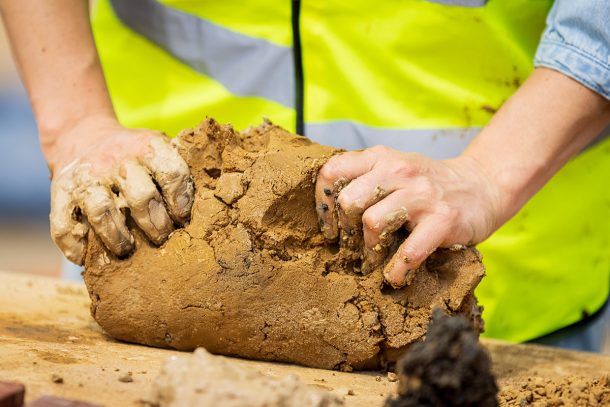
I’m a student on the V&A/RCA History of Design MA programme, and live local to the Brickfield Newham site. Brickfield Newham was a temporary community brickfield set up for May 2021 in the Royal Docks where people came together to make bricks, build a kiln and devise performances about local housing issues. I wanted to join The Brickfield Makers, a week-long residency at Brickfield Newham, as after two terms of online learning, I wanted to take part in an in-person hands-on public history project.
One of the most important things about The Brickfield Makers was that we had so many conversations about brick! Each maker shared their ideas, experiences, skills and ideas. Here I wanted to share with you a conversation with one of The Brickfield Makers, Kate Longworth.
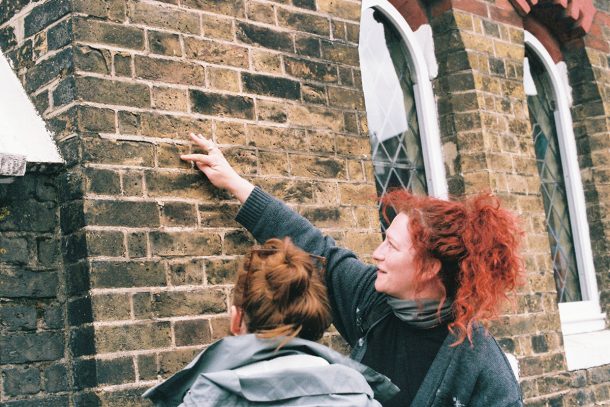
Karen Nicholson Kate, can you begin by introducing yourself?
Kate Longworth I’ve just finished a bricklaying apprenticeship. I went to the Building Crafts College in Stratford, and I’m about to start on The Prince’s Foundation Building Craft Programme. What appealed to me about joining The Brickfield Makers was hand-making bricks and the building of the kiln, because I work with bricks, but I don’t know that much about the process of how they come about.
What did you find when you joined the project?
Each day we were doing different things.
I really enjoyed making the bricks and I wished I had a bit more time doing that because I think it really is an art – and I definitely could have improved a lot with practice!
Going to the V&A when it was closed to the public was a real privilege, and being in that courtyard and studying the building, then translating shapes and designs on to the little briquettes was really good, meeting different people. There was also a big range of ages and backgrounds. I also loved the architectural walkabout because there were just so many places that have been so close to me when I’ve been around college, but never noticed before, and, to have people who truly know the area.
That was fascinating, wasn’t it? On the walkabout you were sharing your construction knowledge too, like you read the buildings in a completely different way. Remember when we were looking at Alice Billings House, the former fire station? You were looking at the bricks over the archtop of the doorway and you were saying how the different formation strengthened it and observed where the fire hose had worn away the masonry.
I loved that, they were very soft bricks. Pointing is such a huge part of brickwork, it can give completely different finishes, and different skills are involved, doing different techniques. I think that needs to be explained when you are looking at a building, not just the shape of the building or the style of it. You can also understand a building by looking at how bricks are combined in different bonds, how they are constructed, what the finish is, I think these are all important things to talk about as well.
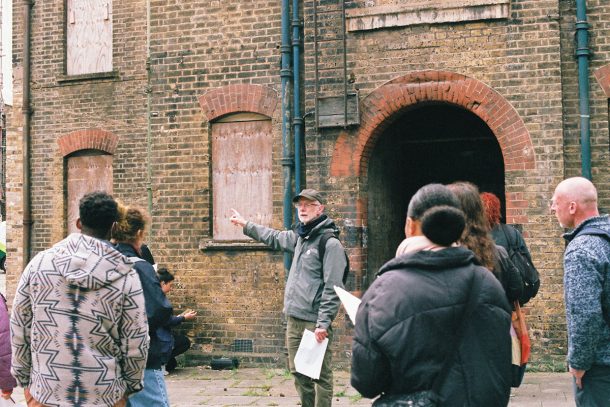
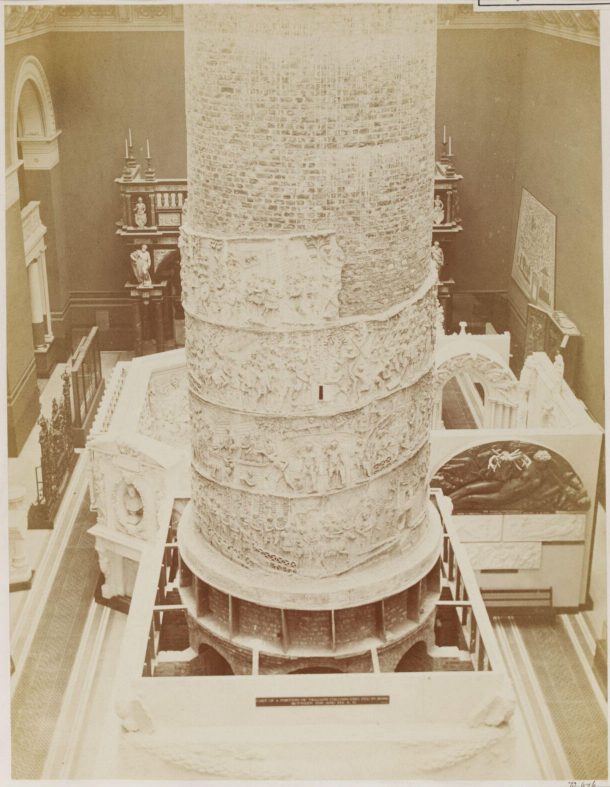
I thought it was interesting when we were in the Cast Court in the V&A and looking at Trajan’s column. Brick cores had been built to support the plaster reliefs. You went inside and you looked straight at the brickwork and told us exactly what the bond was, and why you thought they used it. I think you said it was an English bond?
Oh yes – the strongest bond in brickwork is English bond.
Is English Bond quick to do also, or do other strong bonds take about the same time?
I guess that depends how experienced the bricklayer is! But I’d say English and Flemish take about the same time to build, they both use 120 bricks per square metre.
If you had to build a tall thin column today, would you still use English bond? Or have other types of bonds become more usual?
English bond is still used for its strength, however a lot of the modern brickwork we see today is just basically cladding. Think of a new build going up, it’s blockwork with a skin of brickwork on the outside.
I certainly look at bricks very differently since I’ve done The Brickfield Makers residency. I also walk around Newham with what I think is a different eye, and I think that is probably lasting. I keep looking – for instance – at the outside of my house and thinking, “Where was the brickfield that made these bricks?” It’s a universal topic, and every single person needs shelter and housing, so, as a topic for The Brickfield Makers, the interest was already there, everybody is interested in having a home. So, I thought that it was inspirational but so fundamental as well.
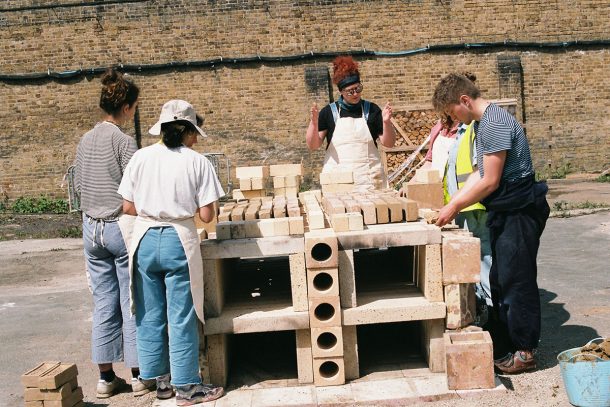
One of the most interesting parts I thought was learning how to build a kiln with Rosanna Martin from Brickfield. Once we had all finished it, we then made small kiln gods to bless the kiln and give us luck with the 30 consecutive hours of wood firing. What did you make for your Kiln God?
A sheep. I made a sheep because I love them, and I spent a lot of time on my family farm when I was growing up in the Yorkshire Dales and stone walls and sheep remind me of being there, and good times.
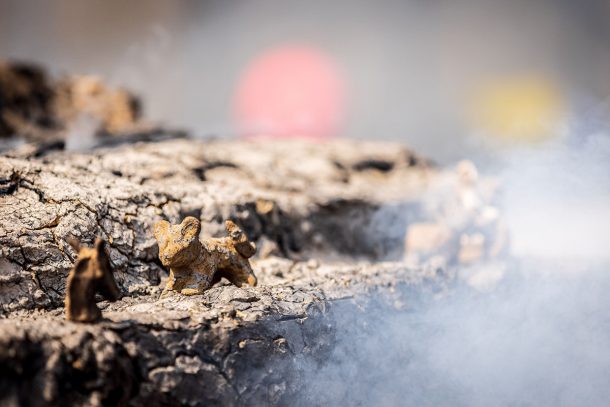
So, would you say […], I know bricklaying is not dry-stone walling, but it is kind of that similar interest in walls and enclosures?
Yeah, definitely, things that shape the landscape and where we live and yes, I have always loved dry-stone walls. Didn’t think that I would love brick walls until I started this apprenticeship so that was, yes, quite a surprise!
You’re surrounded by them all the time, bricks everywhere, and I didn’t realise how much skill – and just how interesting they are. I didn’t think that people still used old techniques, but I wanted to get involved in the trade and after trying to get on an apprenticeship – like a carpentry apprenticeship – for so long, I was like any trade will do, get me on anything. And ended up getting this, but fell in love my first day at college, completely.
Why do you think it was so hard to get on an apprenticeship?
Honestly? I think a few factors played into it. I didn’t have much experience in construction, although I’ve always had an interest and have dabbled in dry-stone walling, thatching and joinery. My age: I was 33 when I started applying and I think companies were looking for younger apprentices. I applied to lots advertised online but I also used to call round firms and ask if they took on apprentices; it wasn’t unusual for them to ask if I was calling on behalf of my son! And I guess that leads on to another factor, I’m a woman. I was shocked at how some people were so against having a woman work for them! Even when I had finally got an apprenticeship, I was told on my first day, by my then manager, that he fought not to have me there, he didn’t want a woman on his team etc. So yeah, I think a few things made it hard.
That sounds difficult to cope with.
I would say that there’s been – I’ve definitely had negative experiences but also some really positive ones. I feel that there is a pressure on me to do a bit better to kind of prove I can do it, some people if they see you or see your name, an opinion automatically forms in their head so yeah, that’s great because it makes me try harder and it makes me more determined, I think.
Brickfield Newham
A new film made by amaka lin. about Brickfield Newham will be showing at the V&A for London Design Festival 18 September – 26 September, alongside a display of the bricks made at the site.
Brickfield Newham is a V&A Research Institute and V&A East collaboration in partnership with St. Austell’s artist-led project Brickfield and University of East London’s Performing Arts department. Supported by the Andrew W. Mellon Foundation, Newham Heritage Month and Arts Council England. The project was created by Georgia Haseldine (V&A), Rosanna Martin (Brickfield) and Lynne McCarthy (UEL).


